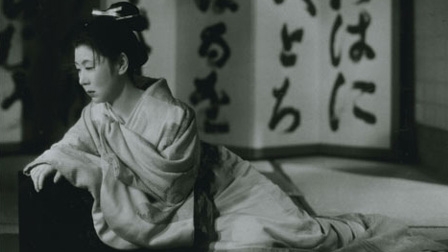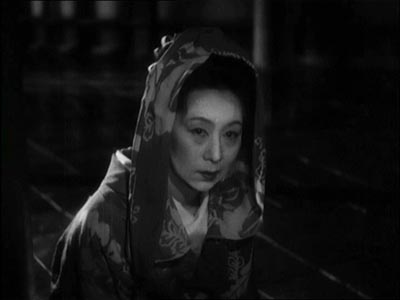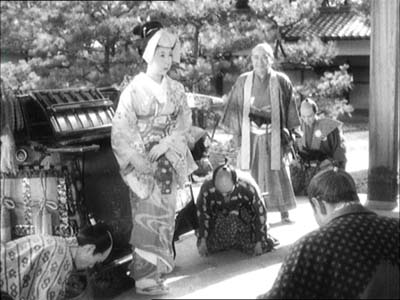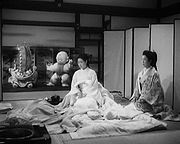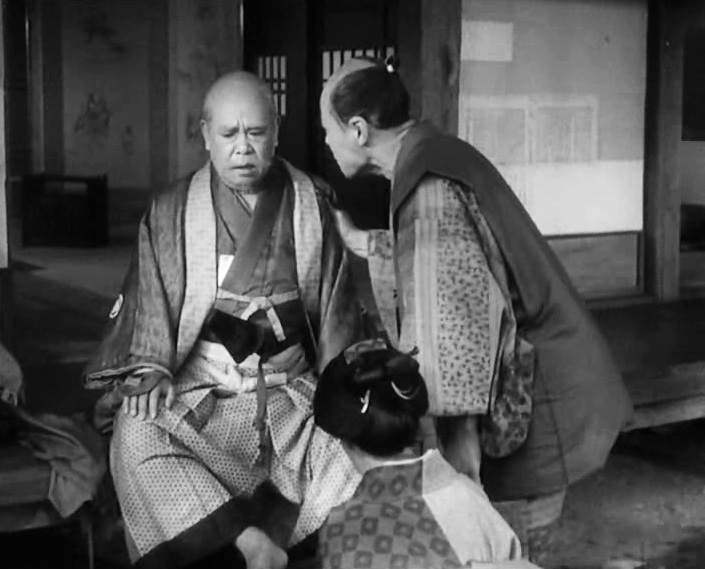This review appeared in the March 1975 issue of Monthly Film Bulletin. —J.R.
Saikaku Ichidai Onna (The Life of Oharu)
Japan, 1952 Director: Kenji Mizoguchi
According to scriptwriter Yoda Yoshikata, Mizoguchi’s ambitions for The Life of Oharu were largely stimulated by the prize accorded to Kurosawa, a relative newcomer, for Rashomon at Venice in 1951. The bet paid off, and Oharu was awarded the Silver Lion at Venice in 1952, thereby inaugurating Mizoguchi’s international reputation at the age of fifty-six, four years before his death. Differing substantially from Saikaku’s novel –- a looser collection of episodes narrated by an elderly nun recalling her decline from a promising youth, and ending with a scene of a prostitute entering a temple and hallucinating the faces of former lovers in the idols there -– Oharu’s script gravitates round the feudal persecutions of one woman. It appears that Mizoguchi was something of a Stroheim on the set -– requiring that the garden of Kyoto’s Koetsu temple be “rebuilt” instead of using the nearly identical original location, and firing his assistant, Uchikawa Seichiro, when the latter complained about making last-minute changes in the positions of the studio-built houses for the scene of Bunkichi’s arrest. Intransigence of this sort seems borne out by the relentless polemical thrust of Oharu, which quite likely comprises the most powerful feminist protest ever recorded on film. (It may not be entirely accidental that Kinuyo Tanaka, the extraordinary actress playing Oharu, went on to become the first woman director in Japan the following year.) Eschewing the elements of fantasy and myth that figure in his subsequent period films (excepting only Chikamatsu Monogatari, which it resembles in other respects, Oharu combines the form of the picaresque novel with much of the social analysis common to Mizoguchi’s “contemporary” geisha films. Above all, it is a materialist analysis –- a depiction of woman treated, traded, valued, degraded, and discarded as material object: the inspection of Kyoto’s “most beautiful” women by Matsudaira’s servant (delineated in one lengthy tracking shot), periodically checking the details of his model drawing against the “specimens” offered; the remarkable subplot of the vulgar big-spender at the Shimabara brothel, who throws fistfuls of coins to watch the courtesans fight and scramble –- valuing Oharu “highest” because she refuses to participate, and then purchasing her as a consequence –- and cackling “Money is everything”, before being unveiled as a counterfeiter; the black comedy in the wealthy merchant’s home about the wife’s loss of her hair, her spiteful cutting of Oharu’s, and Oharu’s revenge of getting a kitten to make off with the former’s wig. The obi (sash) that Oharu’s husband is clutching when he is killed is subsequently discarded in a strip tease where she “pays” Yakichi for his material by throwing it at him, offering her body at the same time. The pagoda that she acknowledges in the final shot, visually echoing the shape of her hat, implies her equivalence to an object, while the camera remaining on the pagoda after she has left the frame -– like its lingering on the ground of Kibukozi’s garden after she and Katsunosuke leave on their lovers’ tryst, or on a tree in a courtyard during the flight of the uncovered counterfeiter –- suggests that all these things will outlast her. The predilection of French critics for linking Mizoguchi with Murnau seems largely dictated by this sense of fatality, expressed equally by the striking high-angle shots, a fairly constant use of the diagonal line, and the movement between the “sympathy” and autonomy of several extended camera movements in relation to Oharu: her endless flight of despair through the woods after reading Katsunosuke’s parting message to her; her nocturnal street walk in the opening shot –- repeated near the film’s close –- as an axis round which things happen, which closely resembles the City Woman’s walk in Sunrise. But quite apart from the visual rendering of Oharu’s condition and fate –- a “statement” that is made no less contemporary by the beauty and density of its period detail –- one must also consider Ichiro Saito’s prodigious musical score. From the solo instrument accompanying Oharu and her parents’ departure from Kyoto to the percussive wooden blocks punctuating the grunts of the men carrying Matsudaira’s servant there; from Oharu’s discovery of an old courtesan singing in a broken voice to her later recapitulation of the same song, in comparable circumstances; from the dead silence when she sees her son passing on the road as a child to the throbbing harp-like arpeggios that accompany her brief glimpse of him as a man — Oharu’s soundtrack achieves a rare diversity of effect that never deviates from the film’s sustained emotional and narrative rigor. By the time we reach the choral passage over the closing shot, we have arrived at a sublime tabula rasa that perfectly complements the one we see on the screen: as with the closing shots of Queen Christina and Les Bonnes Femmes, it is a coda that tells us nothing and, by doing so, expresses everything.
JONATHAN ROSENBAUM
—Monthly Film Bulletin, March 1975 (vol. 42, no. 494)

